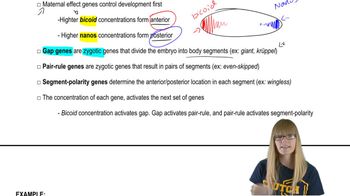In the globin gene family (shown in the below diagram), which pair of genes would exhibit a higher level of sequence similarity, the human δ-globin and human β-globin genes or the human β-globin and chimpanzee β-globin genes? Can you explain your answer in terms of the timing of gene duplications?
Table of contents
- 1. Introduction to Genetics51m
- 2. Mendel's Laws of Inheritance3h 37m
- 3. Extensions to Mendelian Inheritance2h 41m
- 4. Genetic Mapping and Linkage2h 28m
- 5. Genetics of Bacteria and Viruses1h 21m
- 6. Chromosomal Variation1h 48m
- 7. DNA and Chromosome Structure56m
- 8. DNA Replication1h 10m
- 9. Mitosis and Meiosis1h 34m
- 10. Transcription1h 0m
- 11. Translation58m
- 12. Gene Regulation in Prokaryotes1h 19m
- 13. Gene Regulation in Eukaryotes44m
- 14. Genetic Control of Development44m
- 15. Genomes and Genomics1h 50m
- 16. Transposable Elements47m
- 17. Mutation, Repair, and Recombination1h 6m
- 18. Molecular Genetic Tools19m
- 19. Cancer Genetics29m
- 20. Quantitative Genetics1h 26m
- 21. Population Genetics50m
- 22. Evolutionary Genetics29m
15. Genomes and Genomics
Comparative Genomics
Problem 24b
Textbook Question
Dominguez et al. (2004) suggest that by studying genes that determine growth and tissue specification in the eye of Drosophila, much can be learned about human eye development.
What evidence indicates that the eyeless gene is part of a developmental network?
 Verified step by step guidance
Verified step by step guidance1
Understand the concept of a developmental network: It refers to a group of genes that interact with each other to control the development of a specific organ or tissue, such as the eye.
Recognize that the eyeless gene in Drosophila is homologous to the Pax6 gene in humans, which is known to play a crucial role in eye development across species.
Examine experimental evidence showing that mutations in the eyeless gene lead to defects in eye formation, indicating its essential role in the developmental process.
Look for studies demonstrating that the eyeless gene regulates or interacts with other genes involved in growth and tissue specification, suggesting it functions within a network rather than acting alone.
Consider findings where ectopic expression of the eyeless gene can induce eye development in non-eye tissues, supporting the idea that it is a key regulatory gene within a broader developmental network.
 Verified video answer for a similar problem:
Verified video answer for a similar problem:This video solution was recommended by our tutors as helpful for the problem above
Video duration:
1mPlay a video:
Was this helpful?
Key Concepts
Here are the essential concepts you must grasp in order to answer the question correctly.
Developmental Gene Networks
Developmental gene networks are interconnected groups of genes that regulate the growth and formation of tissues and organs. These networks involve genes that control each other's expression, creating coordinated patterns essential for proper development. Understanding these networks helps explain how complex structures like the eye form from genetic instructions.
Recommended video:
Guided course

Segmentation Genes
The Eyeless Gene and Its Role
The eyeless gene in Drosophila is a master regulatory gene that controls eye development by activating other genes in the pathway. Its function is conserved across species, meaning similar genes influence eye formation in humans. Evidence of its role in a network includes its ability to regulate multiple downstream targets and interact with other developmental genes.
Recommended video:
Guided course

Segmentation Genes
Conservation of Genetic Pathways Across Species
Many developmental genes and pathways are conserved between species, such as between fruit flies and humans. This conservation means studying genes like eyeless in Drosophila can reveal insights into human development. Similar gene functions and interactions across species support the idea that eyeless is part of a broader, evolutionarily conserved developmental network.
Recommended video:
Guided course

History of Genetics
Related Videos
Related Practice
Textbook Question
478
views


